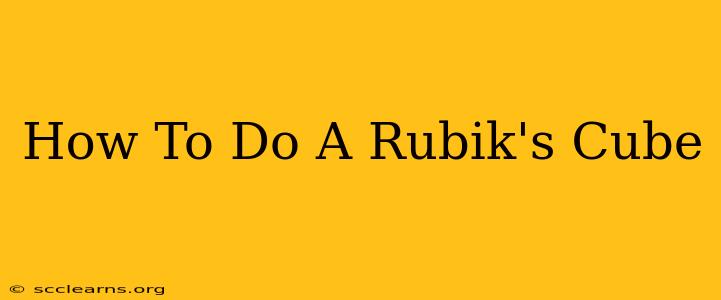The Rubik's Cube: a seemingly impossible puzzle that has captivated minds for decades. But don't be intimidated! Solving a Rubik's Cube is achievable with patience and the right techniques. This guide will break down the process into manageable steps, turning you from a beginner to a Rubik's Cube solver.
Understanding the Notation
Before we begin, it's essential to understand the standard notation used to describe Rubik's Cube moves. This will make following the instructions much easier. We'll use the following:
- F (Front): The face you're looking at.
- B (Back): The face opposite the front.
- R (Right): The face to your right.
- L (Left): The face to your left.
- U (Up): The face on top.
- D (Down): The face on the bottom.
A single letter (e.g., R) indicates a 90-degree clockwise turn of that face. Adding an apostrophe (e.g., R') indicates a 90-degree counter-clockwise turn. A '2' (e.g., R2) indicates a 180-degree turn.
The Beginner's Method: Solving the Cube Layer by Layer
This method breaks down solving the cube into seven stages. Don't worry if it seems complex at first; each step is explained clearly.
Stage 1: The White Cross
This stage focuses on creating a white cross on the top face (U). This involves manipulating the edge pieces to position them correctly, with their white sides facing up and aligning with the center pieces. This requires a bit of intuition and practice. Try to get the white edges positioned correctly before worrying about their orientation.
Stage 2: Completing the White Corners
Once the white cross is done, complete the white corners. These are the pieces with white on one side and another color on the two other sides. These pieces must be moved into their correct spots, completing the first layer.
Stage 3: The Middle Layer
Now comes solving the middle layer. This involves inserting the four edge pieces into their correct positions without disturbing the first layer already completed. This stage requires careful planning and execution.
Stage 4: The Yellow Cross
Flip the cube over. The goal is to create a yellow cross on the top face. Several algorithms (sequences of moves) can achieve this, but one common method involves using a series of intuitive moves to manipulate the yellow edges.
Stage 5: Orient the Yellow Edges
You now have a yellow cross, but the edges might not be oriented correctly. An algorithm, commonly known as "The Sune" can help orient these edges to complete the yellow face.
Stage 6: Permute the Yellow Corners
With the yellow face complete, focus on getting the yellow corners into the correct positions. An algorithm, known as the "H-Perm" is often utilized to correctly position these corners.
Stage 7: Orient the Yellow Corners
The final step involves correctly orienting the yellow corners. An algorithm similar to the "U-Perm" can help here. This completes the Rubik's Cube!
Tips for Success
- Practice Makes Perfect: The key to mastering the Rubik's Cube is consistent practice. Start slowly, focusing on understanding each step before moving to the next.
- Use Visual Aids: Videos and diagrams can significantly aid in learning the algorithms and visualizing the steps. There are numerous tutorials available online.
- Don't Give Up: It may seem frustrating at times, but don't get discouraged. With persistence, you'll be solving the cube in no time!
- Find Your Style: There are many methods for solving a Rubik's Cube. Once comfortable with the beginner's method, explore advanced techniques for faster solves.
Solving a Rubik's Cube is a rewarding experience. It's a testament to patience, problem-solving skills, and the power of breaking down complex tasks into smaller, manageable steps. So grab your cube, follow these steps, and enjoy the satisfaction of conquering this classic puzzle!

